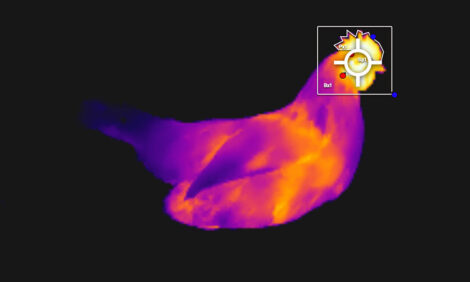



Poultry Outlook Report - June 2003
By U.S.D.A., Economic Research Service - This article is an extract from the June 2003: Livestock, Dairy and Poultry Outlook Report, highlighting Global Poultry Industry data. This report indicates a decline in broiler production.
Poultry Outlook Report - June 2003 - By U.S.D.A., Economic Research Service - This article is an extract from the June 2003: Livestock, Dairy and Poultry Outlook Report, highlighting Global Poultry Industry data. This report indicates a decline in broiler production.
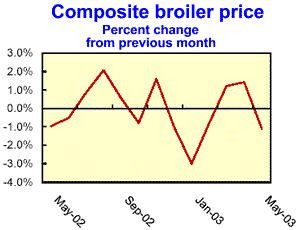 U.S. broiler production totaled 2.72 billion pounds in April, 1.1 percent lower than the previous year. The production decline in April was the result of 3 percent fewer birds slaughtered offset partially by a 1.6-percent increase in the average liveweight. This pattern is expected to continue for at least the next 2 months, with smaller numbers of birds going to slaughter compared with the previous year, but with higher liveweights.
U.S. broiler production totaled 2.72 billion pounds in April, 1.1 percent lower than the previous year. The production decline in April was the result of 3 percent fewer birds slaughtered offset partially by a 1.6-percent increase in the average liveweight. This pattern is expected to continue for at least the next 2 months, with smaller numbers of birds going to slaughter compared with the previous year, but with higher liveweights.
Broiler production has fallen in 4 of the last 5 months (after an adjustment in production, March was unchanged compared with the previous year). Weekly egg sets and chicks placed are continuing to be lower than for the same week a year earlier. Broiler production in the first quarter is now estimated at 7.77 billion pounds, down 0.6 percent from a year earlier.
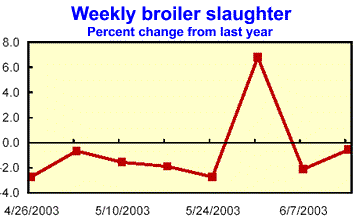 Production for the second quarter is estimated to increase to 8.15 billion pounds, but this is still 1.0 percent below the previous year. Production is expected to be down somewhat in the third quarter, but increase slightly in the fourth quarter of 2003 in reaction to strengthening prices.
Production for the second quarter is estimated to increase to 8.15 billion pounds, but this is still 1.0 percent below the previous year. Production is expected to be down somewhat in the third quarter, but increase slightly in the fourth quarter of 2003 in reaction to strengthening prices.
With first-quarter production lower, exports about the same, and stocks down, wholesale prices for a number of broiler products have begun to strengthen. Over the first 5 months of 2003, prices for boneless/skinless breast meat have averaged $1.46 per pound, up 14 percent from the same period in 2002.
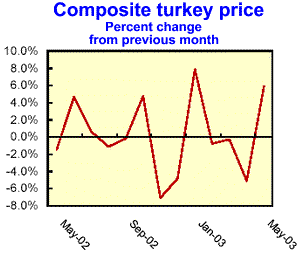 Prices for whole birds have also increased, with prices averaging 7 percent higher than the previous year. Leg-quarter prices, which more greatly reflect strength in the export markets, have lagged. Over the first 5 months of 2003 prices have averaged just over 21-cents-a-pound, about 5-percent lower than the previous year.
Prices for whole birds have also increased, with prices averaging 7 percent higher than the previous year. Leg-quarter prices, which more greatly reflect strength in the export markets, have lagged. Over the first 5 months of 2003 prices have averaged just over 21-cents-a-pound, about 5-percent lower than the previous year.
However, prices are beginning to increase. In May, leg-quarter prices at 23.9 cents-a-pound were up 17 percent from May 2002. With broiler production forecast to be below year-earlier levels through the third quarter and smaller supplies of beef and pork available, broiler prices are expected to continue to gradually strengthen.
Broiler exports in the first quarter of 2003 totaled 1.2 billion pounds, almost exactly equal to the previous year. Exports are expected to be higher in the second quarter of 2003 than the previous year. However, that is primarily a function of the drop in exports in the second quarter of 2002 when Russia initially placed a ban on U.S. imports, rather than the result of any growing strength in exports.
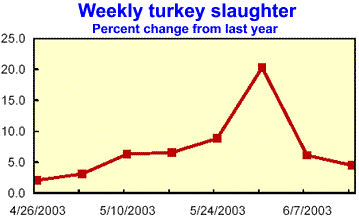 In the first quarter of 2003, exports to the four largest markets (Russia, Hong Kong, Mexico, and Korea) were all considerably lower. These declines were offset by strong growth in shipments to a wide number of other countries. While shipments to Hong Kong were lower, direct shipments to China in the first quarter of 2003 were up over 400 percent.
In the first quarter of 2003, exports to the four largest markets (Russia, Hong Kong, Mexico, and Korea) were all considerably lower. These declines were offset by strong growth in shipments to a wide number of other countries. While shipments to Hong Kong were lower, direct shipments to China in the first quarter of 2003 were up over 400 percent.
Another large growth area has been exports to Cuba. In the first quarter broiler exports to Cuba were over 38 million pound’s, compared with just over 1 million pounds in the same period in 2002.
Total U.S. egg production in 2003, table and hatching, is expected to total about 7.24 billion dozen, up fractionally from 2002. Egg production is expected to increase nearly 1 percent in 2004, due to expected improved returns. Table eggs are expected to account for 85 percent of total production in 2003, and are expected to stay at the same percentage in 2004.
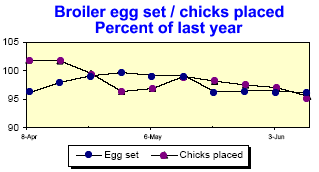 Hatching egg production in 2003 is expected to be nearly unchanged, but is expected to rise by nearly 2 percent in 2004. The rise in 2004 is due to higher expected broiler production. Table egg production is expected to rise by less than 1 percent.
Hatching egg production in 2003 is expected to be nearly unchanged, but is expected to rise by nearly 2 percent in 2004. The rise in 2004 is due to higher expected broiler production. Table egg production is expected to rise by less than 1 percent.
Wholesale table egg prices are expected to average 75-78 cents a dozen in 2003, compared with 67 cents in 2002. The wholesale egg market is a relatively thin market, where small changes in supply can have a large price impact.
Wholesale egg prices in 2004 are expected to average 74-80 cents a dozen as per capita supplies tighten. Retail egg prices in 2003 are expected to rise by about 9 percent. Retail egg prices declined after reaching a peak in 1996, but began to move upward in 2001.
The price spread between wholesale and retail egg prices is expected to narrow in 2004. Per capita egg consumption in 2003 is expected to decrease slightly to 252 eggs, about two eggs less per person than the previous year. Since 1996, U.S. egg consumption has increased by 7 percent or about 17 eggs per person. This is due in large part to increasing demand for breaking eggs by the commercial baking, confectionery, and fast food industries.
This trend was clearly indicated by the amount of eggs going to the breaking market, which increased from 28 percent of total table egg production in 1996 to an expected 31 percent in 2003, and 32 percent forecast in 2004.
U.S. egg exports in 2003 are expected to reach 169 million dozen, down 2-3 percent from the previous year and representing 2.3 percent of total U.S. egg production. Shell eggs (for human consumption and hatching) accounted for nearly 55 percent of total U.S. exports.
The remaining 45 percent were exported as processed albumen and yolk in dried or liquid forms. Five countries: Canada, Belgium, Hong Kong, Japan, and Mexico accounted for 77 percent of all U.S. egg exports in 2002.
The largest export market is Canada, receiving over one quarter of all U.S. egg exports. U.S. egg exports to Canada were twice as large as to Hong Kong, Belgium, Japan, or Mexico.
Total U.S. egg exports are expected to increase about 2-3 percent in 2004.
Source: Livestock, Dairy and Poultry Situation and Outlook - U.S. Department of Agriculture, Economic Research Service - 24th June, 2003
| Overview |
 The recent discovery of bovine spongiform encephalophathy (BSE) in Canada resulted in
the United States placing a ban on imports of ruminant animals and products from that
country as of May 20. Due to the uncertainties as to the length of the ban, the impact of
BSE in this report is limited to impacts of the ban through June 11.
The recent discovery of bovine spongiform encephalophathy (BSE) in Canada resulted in
the United States placing a ban on imports of ruminant animals and products from that
country as of May 20. Due to the uncertainties as to the length of the ban, the impact of
BSE in this report is limited to impacts of the ban through June 11.
Already tight red meat and poultry supply conditions were exacerbated in May and early
June as the cessation of imports of Canadian beef and fed cattle for immediate slaughter
further tightened the supply situation.
| Broiler Production Falls by 1.1 Percent In April |
 U.S. broiler production totaled 2.72 billion pounds in April, 1.1 percent lower than the previous year. The production decline in April was the result of 3 percent fewer birds slaughtered offset partially by a 1.6-percent increase in the average liveweight. This pattern is expected to continue for at least the next 2 months, with smaller numbers of birds going to slaughter compared with the previous year, but with higher liveweights.
U.S. broiler production totaled 2.72 billion pounds in April, 1.1 percent lower than the previous year. The production decline in April was the result of 3 percent fewer birds slaughtered offset partially by a 1.6-percent increase in the average liveweight. This pattern is expected to continue for at least the next 2 months, with smaller numbers of birds going to slaughter compared with the previous year, but with higher liveweights.
Broiler production has fallen in 4 of the last 5 months (after an adjustment in production, March was unchanged compared with the previous year). Weekly egg sets and chicks placed are continuing to be lower than for the same week a year earlier. Broiler production in the first quarter is now estimated at 7.77 billion pounds, down 0.6 percent from a year earlier.
 Production for the second quarter is estimated to increase to 8.15 billion pounds, but this is still 1.0 percent below the previous year. Production is expected to be down somewhat in the third quarter, but increase slightly in the fourth quarter of 2003 in reaction to strengthening prices.
Production for the second quarter is estimated to increase to 8.15 billion pounds, but this is still 1.0 percent below the previous year. Production is expected to be down somewhat in the third quarter, but increase slightly in the fourth quarter of 2003 in reaction to strengthening prices.
With first-quarter production lower, exports about the same, and stocks down, wholesale prices for a number of broiler products have begun to strengthen. Over the first 5 months of 2003, prices for boneless/skinless breast meat have averaged $1.46 per pound, up 14 percent from the same period in 2002.
 Prices for whole birds have also increased, with prices averaging 7 percent higher than the previous year. Leg-quarter prices, which more greatly reflect strength in the export markets, have lagged. Over the first 5 months of 2003 prices have averaged just over 21-cents-a-pound, about 5-percent lower than the previous year.
Prices for whole birds have also increased, with prices averaging 7 percent higher than the previous year. Leg-quarter prices, which more greatly reflect strength in the export markets, have lagged. Over the first 5 months of 2003 prices have averaged just over 21-cents-a-pound, about 5-percent lower than the previous year.
However, prices are beginning to increase. In May, leg-quarter prices at 23.9 cents-a-pound were up 17 percent from May 2002. With broiler production forecast to be below year-earlier levels through the third quarter and smaller supplies of beef and pork available, broiler prices are expected to continue to gradually strengthen.
Broiler exports in the first quarter of 2003 totaled 1.2 billion pounds, almost exactly equal to the previous year. Exports are expected to be higher in the second quarter of 2003 than the previous year. However, that is primarily a function of the drop in exports in the second quarter of 2002 when Russia initially placed a ban on U.S. imports, rather than the result of any growing strength in exports.
 In the first quarter of 2003, exports to the four largest markets (Russia, Hong Kong, Mexico, and Korea) were all considerably lower. These declines were offset by strong growth in shipments to a wide number of other countries. While shipments to Hong Kong were lower, direct shipments to China in the first quarter of 2003 were up over 400 percent.
In the first quarter of 2003, exports to the four largest markets (Russia, Hong Kong, Mexico, and Korea) were all considerably lower. These declines were offset by strong growth in shipments to a wide number of other countries. While shipments to Hong Kong were lower, direct shipments to China in the first quarter of 2003 were up over 400 percent.
Another large growth area has been exports to Cuba. In the first quarter broiler exports to Cuba were over 38 million pound’s, compared with just over 1 million pounds in the same period in 2002.
| Higher Prices To Dominate the Egg Market In 2003 |
Total U.S. egg production in 2003, table and hatching, is expected to total about 7.24 billion dozen, up fractionally from 2002. Egg production is expected to increase nearly 1 percent in 2004, due to expected improved returns. Table eggs are expected to account for 85 percent of total production in 2003, and are expected to stay at the same percentage in 2004.
 Hatching egg production in 2003 is expected to be nearly unchanged, but is expected to rise by nearly 2 percent in 2004. The rise in 2004 is due to higher expected broiler production. Table egg production is expected to rise by less than 1 percent.
Hatching egg production in 2003 is expected to be nearly unchanged, but is expected to rise by nearly 2 percent in 2004. The rise in 2004 is due to higher expected broiler production. Table egg production is expected to rise by less than 1 percent.
Wholesale table egg prices are expected to average 75-78 cents a dozen in 2003, compared with 67 cents in 2002. The wholesale egg market is a relatively thin market, where small changes in supply can have a large price impact.
Wholesale egg prices in 2004 are expected to average 74-80 cents a dozen as per capita supplies tighten. Retail egg prices in 2003 are expected to rise by about 9 percent. Retail egg prices declined after reaching a peak in 1996, but began to move upward in 2001.
The price spread between wholesale and retail egg prices is expected to narrow in 2004. Per capita egg consumption in 2003 is expected to decrease slightly to 252 eggs, about two eggs less per person than the previous year. Since 1996, U.S. egg consumption has increased by 7 percent or about 17 eggs per person. This is due in large part to increasing demand for breaking eggs by the commercial baking, confectionery, and fast food industries.
This trend was clearly indicated by the amount of eggs going to the breaking market, which increased from 28 percent of total table egg production in 1996 to an expected 31 percent in 2003, and 32 percent forecast in 2004.
U.S. egg exports in 2003 are expected to reach 169 million dozen, down 2-3 percent from the previous year and representing 2.3 percent of total U.S. egg production. Shell eggs (for human consumption and hatching) accounted for nearly 55 percent of total U.S. exports.
The remaining 45 percent were exported as processed albumen and yolk in dried or liquid forms. Five countries: Canada, Belgium, Hong Kong, Japan, and Mexico accounted for 77 percent of all U.S. egg exports in 2002.
The largest export market is Canada, receiving over one quarter of all U.S. egg exports. U.S. egg exports to Canada were twice as large as to Hong Kong, Belgium, Japan, or Mexico.
Total U.S. egg exports are expected to increase about 2-3 percent in 2004.
Links
For more information view the full Livestock, Dairy and Poultry Situation and Outlook (pdf)Source: Livestock, Dairy and Poultry Situation and Outlook - U.S. Department of Agriculture, Economic Research Service - 24th June, 2003







